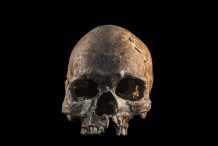Ancient pygmy genes traced in Southeast Asia’s genetic landscape
The head of the DNRF Center for GeoGenetics, Eske Willerslev, is leading an international research team that has mapped genetic immigration in Southeast Asia. The study, which has been published in the scientific journal Science, shows that the reason behind the diversity of the area is more complex than previously thought.

The genetic and cultural diversity among population groups in Southeast Asia is one of the biggest in the world. If you were to travel thousands of years back in time, you would most likely witness a totally different sight than the one that exists now in the area: the inhabitants of that time would not have looked like the modern Southeast Asians of today; rather, they would much more closely resemble African pygmies.
This finding is the result of a big international study based on analysis of archeological DNA from bones and teeth originating from ancient skeletons from 28 humans who lived in Southeast Asia within the past 8,000 years. The study was carried out by researchers from 43 universities in several countries, including Japan, Thailand, France, and Denmark, and was led by Ph.D. student Hugh McColl at the Center for GeoGenetics together with the head of the center, Eske Willerslev.
For more than 100 years, researchers across the world have disagreed on how the immigration had taken place, and two competing theories have dominated the discussion. One theory believed that the indigenous Hòabìnhian hunter-gatherers who populated Southeast Asia around 44,000 years ago from Africa developed into agricultural farmers without influences from early farmers from Southeast Asia. The second theory favors the view that Chinese rice farmers immigrated to the area and replaced the indigenous Hòabìnhian hunter-gatherers.
Willerslev and McColl’s new study now shows that neither of the two theories is accurate and that immigration in Southeast Asia is a much more complex matter.
“The current Southeast Asian genetics seem to have been shaped by four immigrations. The first one took place when remnants from the African people who left Africa around 60,000-70,000 years ago first settled in the area around 40,000 years ago. These people, the Hòabìnhian culture, lived relatively undisturbed for a long time, but around 4,000 years ago they met another group that had immigrated to the area. These were a people from the present Chinese area – people who mastered agriculture and literally brought rice with them. That was the second immigration to Southeast Asia. And around 2,000 years ago the third immigration took place, and then the fourth from Taiwan and once again from China,” said Willerslev.
The study’s point of departure is how the immigration to Southeast Asia happened more specifically: which population groups arrived when, and how they either integrated with each other or how they replaced each other. The researchers tried to answer these questions by making complete mappings of each of the 28 skeletons’ individual DNA material, also known as genomes. The old skeletons are those of people from Malaysia, Laos, and Japan, and as a part of the examination, the researchers compared the genetic material with archeological material in terms of tools and similar human-made artifacts from dated excavations in the area.
Besides the mapping of the complex immigration, the research team found that despite the fact that the indigenous Hòabìnhian inhabitants withdrew to the smaller Southeast Asian islands over time, the researchers cannot say that they were replaced by other population groups.
Analysis of the old bone and teeth material rather suggests that genes from the physically short Hòabìnhian people were mixed with genes from the taller immigrants from China, and that is why some of the Hòabìnhian people’s pygmy genes have remained in humans up to this day.
“The two groups had sexual intercourse with each other, and in that way, the pygmy genes were embedded in the Southeast Asian gene-pool, where they still exist. One can wonder if this is one of the reasons why the majority of Southeast Asians – compared to Europeans, for instance — are physically so small. It is probably not an explanation that covers the question totally, but it is most likely a contributing factor,” explained Willerslev.
Find the scientific publication in Science here.
More information about the research results at the University of Cambridge here.
